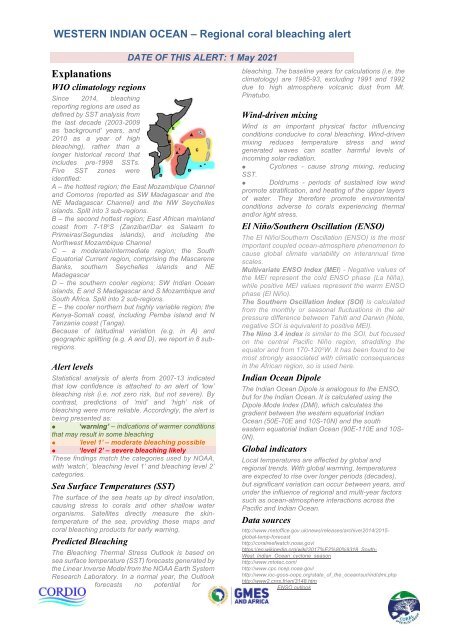WIO bleaching alert-21-05-01
Eighth and last WIO coral bleaching alert 2021 season
Eighth and last WIO coral bleaching alert 2021 season
Create successful ePaper yourself
Turn your PDF publications into a flip-book with our unique Google optimized e-Paper software.
WESTERN INDIAN OCEAN – Regional coral <strong>bleaching</strong> <strong>alert</strong><br />
Explanations<br />
<strong>WIO</strong> climatology regions<br />
DATE OF THIS ALERT: 1 May 20<strong>21</strong><br />
Since 2<strong>01</strong>4, <strong>bleaching</strong><br />
reporting regions are used as<br />
defined by SST analysis from<br />
the last decade (2003-2009<br />
as ‘background’ years, and<br />
2<strong>01</strong>0 as a year of high<br />
<strong>bleaching</strong>), rather than a<br />
longer historical record that<br />
includes pre-1998 SSTs.<br />
Five SST zones were<br />
identified:<br />
A – the hottest region; the East Mozambique Channel<br />
and Comoros (reported as SW Madagascar and the<br />
NE Madagascar Channel) and the NW Seychelles<br />
islands. Split into 3 sub-regions.<br />
B – the second hottest region; East African mainland<br />
coast from 7-18 o S (Zanzibar/Dar es Salaam to<br />
Primeiras/Segundas islands), and including the<br />
Northwest Mozambique Channel<br />
C – a moderate/intermediate region; the South<br />
Equatorial Current region, comprising the Mascarene<br />
Banks, southern Seychelles islands and NE<br />
Madagascar<br />
D – the southern cooler regions; SW Indian Ocean<br />
islands, E and S Madagascar and S Mozambique and<br />
South Africa. Split into 2 sub-regions.<br />
E – the cooler northern but highly variable region; the<br />
Kenya-Somali coast, including Pemba island and N<br />
Tanzania coast (Tanga).<br />
Because of latitudinal variation (e.g. in A) and<br />
geographic splitting (e.g. A and D), we report in 8 subregions.<br />
Alert levels<br />
Statistical analysis of <strong>alert</strong>s from 2007-13 indicated<br />
that low confidence is attached to an <strong>alert</strong> of ‘low’<br />
<strong>bleaching</strong> risk (i.e. not zero risk, but not severe). By<br />
contrast, predictions of ‘mid’ and ‘high’ risk of<br />
<strong>bleaching</strong> were more reliable. Accordingly, the <strong>alert</strong> is<br />
being presented as:<br />
● ‘warning’ – indications of warmer conditions<br />
that may result in some <strong>bleaching</strong><br />
● ‘level 1’ – moderate <strong>bleaching</strong> possible<br />
●<br />
‘level 2’ – severe <strong>bleaching</strong> likely<br />
These findings match the categories used by NOAA,<br />
with ‘watch’, ‘<strong>bleaching</strong> level 1’ and <strong>bleaching</strong> level 2’<br />
categories.<br />
Sea Surface Temperatures (SST)<br />
The surface of the sea heats up by direct insolation,<br />
causing stress to corals and other shallow water<br />
organisms. Satellites directly measure the skintemperature<br />
of the sea, providing these maps and<br />
coral <strong>bleaching</strong> products for early warning.<br />
Predicted Bleaching<br />
The Bleaching Thermal Stress Outlook is based on<br />
sea surface temperature (SST) forecasts generated by<br />
the Linear Inverse Model from the NOAA Earth System<br />
Research Laboratory. In a normal year, the Outlook<br />
forecasts no potential for<br />
<strong>bleaching</strong>. The baseline years for calculations (i.e. the<br />
climatology) are 1985-93, excluding 1991 and 1992<br />
due to high atmosphere volcanic dust from Mt.<br />
Pinatubo.<br />
Wind-driven mixing<br />
Wind is an important physical factor influencing<br />
conditions conducive to coral <strong>bleaching</strong>. Wind-driven<br />
mixing reduces temperature stress and wind<br />
generated waves can scatter harmful levels of<br />
incoming solar radiation.<br />
● Cyclones - cause strong mixing, reducing<br />
SST.<br />
●<br />
Doldrums - periods of sustained low wind<br />
promote stratification, and heating of the upper layers<br />
of water. They therefore promote environmental<br />
conditions adverse to corals experiencing thermal<br />
and/or light stress.<br />
El Niño/Southern Oscillation (ENSO)<br />
The El Niño/Southern Oscillation (ENSO) is the most<br />
important coupled ocean-atmosphere phenomenon to<br />
cause global climate variability on interannual time<br />
scales.<br />
Multivariate ENSO Index (MEI) - Negative values of<br />
the MEI represent the cold ENSO phase (La Niña),<br />
while positive MEI values represent the warm ENSO<br />
phase (El Niño).<br />
The Southern Oscillation Index (SOI) is calculated<br />
from the monthly or seasonal fluctuations in the air<br />
pressure difference between Tahiti and Darwin (Note,<br />
negative SOI is equivalent to positive MEI).<br />
The Nino 3.4 index is similar to the SOI, but focused<br />
on the central Pacific Niño region, straddling the<br />
equator and from 170-120 o W. It has been found to be<br />
most strongly associated with climatic consequences<br />
in the African region, so is used here.<br />
Indian Ocean Dipole<br />
The Indian Ocean Dipole is analogous to the ENSO,<br />
but for the Indian Ocean. It is calculated using the<br />
Dipole Mode Index (DMI), which calculates the<br />
gradient between the western equatorial Indian<br />
Ocean (50E-70E and 10S-10N) and the south<br />
eastern equatorial Indian Ocean (90E-110E and 10S-<br />
0N).<br />
Global indicators<br />
Local temperatures are affected by global and<br />
regional trends. With global warming, temperatures<br />
are expected to rise over longer periods (decades),<br />
but significant variation can occur between years, and<br />
under the influence of regional and multi-year factors<br />
such as ocean-atmosphere interactions across the<br />
Pacific and Indian Ocean.<br />
Data sources<br />
http://www.metoffice.gov.uk/news/releases/archive/2<strong>01</strong>4/2<strong>01</strong>5-<br />
global-temp-forecast<br />
http://coralreefwatch.noaa.gov/<br />
https://en.wikipedia.org/wiki/2<strong>01</strong>7%E2%80%9318_South-<br />
West_Indian_Ocean_cyclone_season<br />
http://www.mtotec.com/<br />
http://www.cpc.ncep.noaa.gov/<br />
http://www.ioc-goos-oopc.org/state_of_the_ocean/sur/ind/dmi.php<br />
http://www2.cnrs.fr/en/3148.htm<br />
ENSO outlook

















